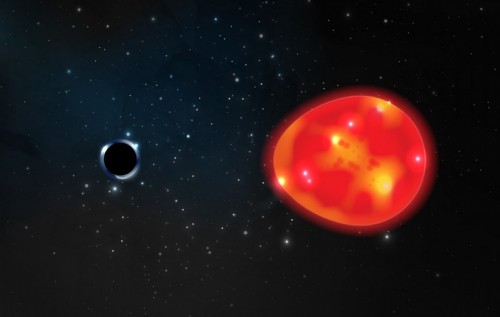Astronomers again think they have found the black hole nearest to us, just 1,500 light-years away, but the find still needs to be confirmed.

Lauren Fanfer / Ohio State University
If Ohio State University astronomers are right, the invisible companion of the red giant star V723 Monocerotis (in the constellation the Unicorn) is the nearest black hole in the universe at 1,500 light-years away. But not everyone is convinced.
V723 Mon is an 8.3-magnitude variable red giant star about as massive as our Sun but some 25 times larger. Astronomers had previously catalogued it as an eclipsing binary, in which a second, unseen star passes over it from Earth’s perspective about every 60 days.
However, when Ohio State PhD candidate Tharindu Jayasinghe took a close look at archival data from three automated telescopes — the All-Sky Automated Survey (ASAS), the Kilodegree Extremely Little Telescope (KELT), and the Transiting Exoplanet Survey Satellite (TESS) — he found that the brightness variations observed before instead indicated that tidal forces from a more massive companion had distorted the star into a tear-drop shape.
In a study that will appear in Monthly Notices of the Royal Astronomical Society (preprint available here), Jayasinghe’s team uses the system’s period, the orbital velocity, and the inferred distortion of the red giant to derive the mass of its invisible companion: three solar masses. They claim that a single compact body, that is, a low-mass black hole, is the most likely explanation.
Based on an independent analysis, Kento Masuda (Osaka University, Japan) and Teruyuki Hirano (NINS, Japan) arrive at a similar conclusion in a paper posted on the arXiv preprint server. If confirmed, the “Unicorn,” as Jayasinghe and his colleagues have dubbed the object — both for its location on the sky and its uniqueness — would be the closest known black hole.
However, Edward van den Heuvel (University of Amsterdam) says he is skeptical about the purported evidence for such “non-interacting” low-mass black holes, where there’s no mass transfer, accretion disk, and X-ray emission to support the claim.
When a team led by Jayasinghe’s coauthor Todd Thompson (also at Ohio State) published the discovery of another non-interacting 3.3-solar-mass black hole companion to a remote red giant star in Science, van den Heuvel and Thomas Tauris (Aarhus University, Denmark) were quick to point out in a follow-up , also in Science, that the invisible object could very well be a close pair of faint companions instead. Earlier claims of non-interacting black holes – including one in the binary star system HR 6819, at a mere 1,120 light-years away – also didn’t stand the test of time.
So it remains to be seen how many scientists will be convinced of the existence of the Unicorn. Van den Heuvel, for one, believes it is more likely that here, too, the invisible companion is a close pair of low-luminosity stars. “I don’t think they have presented rock-solid proof,” he says.
In the Mass Gap
If V723 Mon does harbor a bona fide black hole, it would be the smallest one ever found. So far, the lowest-mass black hole that astronomers are sure of weighs in at just over 6 solar masses, leaving a “mass gap” between black holes and neutron stars, the latter of which are about twice as massive as the Sun at most.

LIGO-Virgo / Northwestern U. / Frank Elavsky & Aaron Geller
Finding black holes in this mass gap would shed new light on their formation mechanisms. According to van den Heuvel, current theories can only form them when a neutron star accretes enough material to further collapse into a black hole.
Meanwhile, Jayasinghe and his colleagues think their Unicorn may not be entirely unique after all. Based on a rough statistical analysis, they estimate that our Milky Way Galaxy might contain a few hundred similar systems. Future large spectroscopic surveys like APOGEE (part of the ongoing Sloan Digital Sky Survey) and the Chinese LAMOST survey (carried out with the Large-sky Area Multi-Object fibre Spectroscopic Telescope) are expected to yield more compact-object binaries and black hole candidates, they write. According to Jayasinghe, V723 Mon stands out because of its proximity. “It is very bright, so it is relatively cheap to follow up with ground-based facilities,” he says.
 1
1









Comments
Peter Wilson
April 24, 2021 at 8:26 pm
'Ed van den Heuvel says he is skeptical about the purported evidence for such “non-interacting” low-mass black holes, where there’s no mass transfer, accretion disk, and X-ray emission to support the claim.'
Good point!
But wait: "(He) believes it is more likely that here, too, the invisible companion is a close pair of low-luminosity stars."
Okay, but how do you get 3 solar masses of material, binary or otherwise, of low-luminosity, except via BH? I am confused on that part.
You must be logged in to post a comment.
You must be logged in to post a comment.